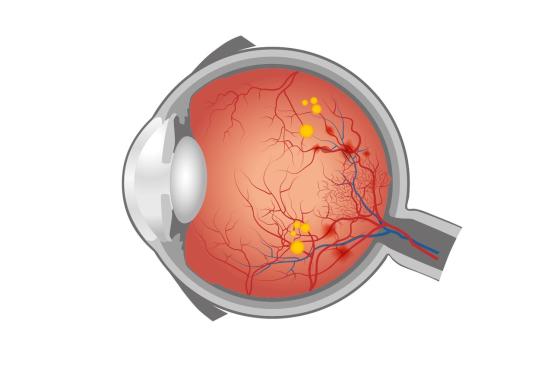Diabetes, a modern pandemic, affects millions of people worldwide. This metabolic disease manifests itself as a persistent rise in blood glucose levels due to insufficient insulin production or cell resistance to this hormone. Although a genetic predisposition may favor its onset, environmental factors such as an unbalanced diet and lack of physical activity are major triggers.
Diabetes is a chronic disease that, over time, can cause serious damage to many organs, including the eyes. Diabetic retinopathy, a common complication, is a leading cause of blindness in adults.
Treatment of diabetic retinopathy: Prices in Turkey
The cost of diabetic retinopathy treatment depends on the severity of the disease and the patient's case. With Turquie Santé, you'll be treated at the best eye clinics in Turkey. Our patients benefit from world-class medical expertise, affordable costs and state-of-the-art healthcare facilities.
Turquie Santé is here to make the whole process easier, from booking your appointment to returning home. Don't hesitate to ask for a quote and detailed information about your case - our specialists are here to help.
- People suffering from diabetic retinopathy.
- Bleeding during medication injections or surgery.
- Retinal detachment.
- Increased intraocular pressure.
- Worsening of macular edema.
- Cataract formation.
- Loss of vision.
Best Clinics with Verified Reviews

- Network of 25 Clinics in Ophthalmology
- 2 Clinics in Germany and 1 in Amsterdam
- 96,000 patients in 2017

- Grand Hospital founded in 1999
- 200 Beds
- 53,000 square meters
Diabetic retinopathy and pathophysiology
Diabetic retinopathy is an eye disease commonly caused by diabetes. It is characterized by damage to the capillaries of the retina. If left untreated, it can lead to serious consequences such as blindness and vision loss.
The severity of the disease is related to certain causes that change it from a non-proliferative to a proliferative retinopathy. These include:
- Long-standing diabetes.
- Uncontrolled blood glucose.
- High blood pressure.

Non-proliferative retinopathy Vs proliferative retinopathy
| Specifications | Non-proliferative retinopathy | Proliferative retinopathy |
| Disease stage | First stage of diabetic retinopathy. | Advanced stage of diabetic retinopathy. |
| Cause | Fat and protein deposits in retinal blood vessels. | Formation of new, abnormal blood vessels in the retina. |
| Funduscopic examination | Yellow or white patches on the retina. | Choroidal neovessels. |
| Treatment | Treatment of hyperglycemia, laser or surgery. | Laser, intravitreal injections, surgery. |
| Prognosis | Risk of irreversible vision loss. | Risk of blindness, vitreous hemorrhage, retinal detachment, risk of neovascular glaucoma. |
Diagnosis of diabetic retinopathy
The diagnosis of diabetic retinopathy requires several essential examinations:
- Fundoscopic examination.
- Color fundus photography.
- Fluorescein angiography.
- Optical coherence tomography (OCT).
These tests allow us to detect retinal abnormalities, classify the severity of retinopathy, assess its extent, and plan appropriate treatment.
The severity of this diabetic complication depends on blood glucose and blood pressure control and the duration of diabetes.
Diabetic retinopathy symptoms
A fundoscopic examination at least once a year is necessary to detect the early signs of diabetic retinopathy. This is advisable because symptoms are not visible in the early stages of the disease. In addition, the symptoms of diabetic retinopathy vary depending on the severity and stage of the disease.
Symptoms of nonproliferative retinopathy
The primary visible symptoms are caused by macular edema. However, there are other signs of non-proliferative retinopathy, such as:
- Microaneurysms.
- Cottony nodules, also known as soft exudates.
- Hard exudates.
- Retinal hemorrhages.
Other signs may appear later, such as:
- Macular edema.
- Venous dilation.
- Microvascular problems.
Symptoms of proliferative retinopathy
The most obvious symptom of proliferative retinopathy is neovascularization. However, other signs can be seen and are often associated with retinal detachment or intravitreal hemorrhage. These signs include
- Blurred vision.
- Bright spots or black spots in the visual field.
- Severe loss of visual acuity.

Treatment of diabetic retinopathy in Turkey : Laser & surgery
The treatment of diabetic retinopathy in Turkey varies according to the progression and severity of the disease. In the early stages, when the disease is not advanced, immediate treatment is not required. Instead, patients are advised to monitor their blood glucose levels to slow the progression of the disease. Regular follow-up with an ophthalmologist is also recommended to determine the right time to start treatment.
In advanced stages, several types of treatment are available, including:
- Laser refractive surgery.
- Laser photocoagulation.
- Focal laser treatment.
- Panretinal photocoagulation.
- Vitrectomy.
- Intravitreal injections to treat macular edema.
Share this page







